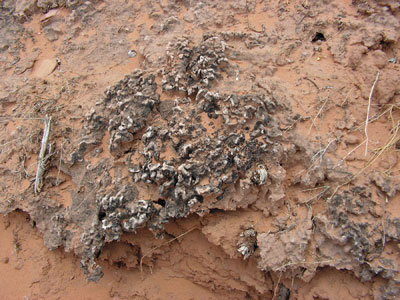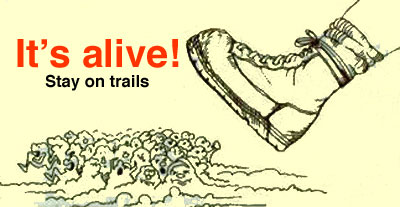BY MARGARET STEWART | FEBRUARY 23, 2011
 Donít bust the crust
Donít bust the crust
Why cryptobiotic crust needs to be protected
What is small, almost invisible, and if you step on it, won’t recover for 250 years? What?! Cryptobiotic crust wasn’t right on the tip of your tongue?
 This is the magic “stuff” that has held the desert floor together for thousands of years. It’s full of tiny living organisms that are a vital part of the desert ecosystem. The crust is found not only in the Sonoran Desert, but also in deserts, hot or cold, around the whole world.
This is the magic “stuff” that has held the desert floor together for thousands of years. It’s full of tiny living organisms that are a vital part of the desert ecosystem. The crust is found not only in the Sonoran Desert, but also in deserts, hot or cold, around the whole world.
This living ground cover is the key to increasing water retention and soil fertility, which in turn reduces soil erosion, three necessary ingredients to a healthy desert.
Cryptobiotic crusts are true biotic communities. Cyanobacteria, one of the oldest known life forms, usually dominate the colony. Lichens, mosses, microfungi, bacteria and green algae join in to form a surface of protection, anchoring the grains of sand below. While these small plants can be seen separately only under a microscope, the crust in the Sonoran Desert can be identified by its bumpy appearance and slightly darker coloring.
The organisms in the crust move through damp soil secreting a sticky mucilage, which literally glues the soil particles in place. Mosses and lichens in the colony are stationary, putting down tiny roots that bind the soil. When these delicate connections in the crust are broken, water runs through the area, instead of being absorbed, and erosion occurs.
As the desert rains, heavy and sporadic, finally come, the crust prevents runoff and absorbs up to ten times its volume. Then it releases the moisture slowly into the soil.
Below the surface of the desert are other organisms, which decompose plant litter, making nutrients available for plants. Crust organisms contribute to this organic matter, as well as provide nitrogen to the soil. The Cyanobacteria also secrete compounds that stimulate plant growth. In this marvelous symbiotic relationship, Nature provides for the needs of the desert soil.
The loss of this kind of interdependent partnership in an ecosystem as fragile as the desert can spell life or death for plants and animals. Once the brittle crypto is compressed by vehicle tires or the feet of livestock or people, soil connections are broken, nutrients are lost, water runs off and soils are left open to damage. Even if the area is not disturbed again, it may take up to 250 years in a desert of low rainfall for recovery to occur.
 The cryptobiotic crust is a valuable web of life for a healthy desert ecosystem, but don’t despair. Staying home isn’t the only way to protect it. When you’re out driving, make sure you stay on established roads and trails. Hikers should use trails, too, or hike the washes and rocks. If you’re camping, stay in designated campgrounds or in areas where crusts don’t grow, like slick rock, beaches or groves of trees. Just stay off the little fellows. They may grow slowly, but they’re so full of life!
The cryptobiotic crust is a valuable web of life for a healthy desert ecosystem, but don’t despair. Staying home isn’t the only way to protect it. When you’re out driving, make sure you stay on established roads and trails. Hikers should use trails, too, or hike the washes and rocks. If you’re camping, stay in designated campgrounds or in areas where crusts don’t grow, like slick rock, beaches or groves of trees. Just stay off the little fellows. They may grow slowly, but they’re so full of life!
Information in this article is from the USGS fact sheet FS-065-01.
Top Photo of Cryptobiotic soil (aka Cryptobiotic Crust, Biological Soil) was taken in Arches National Park/Courtesy Jeffrey McGrath.


